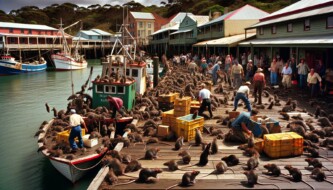Australia’s fishing towns are currently facing a rat plague that has been spreading for several months. The increase in the native rodent population has caused the rats to move towards the coast in search of food. However, many of them do not survive the journey. This has led to an overwhelming number of rats, both dead and alive, washing up on the beaches in Queensland. Residents have reported rats infesting their homes and vehicles, causing damage to property and creating a nuisance.
The town of Normanton has been particularly affected, with residents describing the situation as rats being everywhere. One resident mentioned that the rats had destroyed a car overnight by chewing through the wiring. The rats have also invaded the neighboring town of Karumba, raising concerns about the impact on tourism in the area. Karumba is known for its fishing and birdwatching opportunities, and the presence of rats may deter visitors.
Disturbing images and videos have been shared on social media, showing piles of dead rats on the beaches and large numbers of them floating in the river. The surge in the rat population can be attributed to favorable breeding conditions and a plentiful food supply. Experts predict that the situation may worsen with the expected wet weather in Queensland. Parts of Queensland and New South Wales have already experienced an increase in rodent numbers, reaching plague conditions not seen since 2011.
Local residents, particularly those involved in the fishing industry, are concerned about the long-term effects of the rat plague. They fear that it may tarnish the reputation of Karumba and discourage tourists from visiting. Efforts are being made to manage the rat population and mitigate the damage caused by these pests. However, the situation remains challenging, and residents are bracing themselves for the potential escalation of the rat plague in the coming months.
Original news source: Rat plague spreads to Australia’s fishing towns (BBC)
Listen
Slow
Normal
Fast
Group or Classroom Activities
Warm-up Activities:
– News Summary
Instructions:
1. Divide the class into pairs or small groups.
2. Provide each group with a copy of the article or a summary of the article.
3. Instruct the groups to read the article or summary and collectively create a concise news summary, highlighting the key points.
4. After a designated time, have each group share their news summary with the class.
5. Encourage discussion and compare the different summaries to see if any important information was missed.
– Opinion Poll
Instructions:
1. Divide the class into pairs or small groups.
2. Instruct each group to come up with a list of questions related to the rat plague in Australia’s fishing towns.
3. Have the groups take turns asking the questions to their classmates and recording their responses.
4. After the polling is complete, facilitate a class discussion based on the gathered opinions. Encourage students to explain their viewpoints and engage in respectful debate.
– Vocabulary Pictionary
Instructions:
1. Write a list of vocabulary words from the article on the board.
2. Divide the class into two teams.
3. Call one student from each team to the front of the class.
4. Give each student a vocabulary word from the list.
5. Set a time limit and have the students draw a visual representation of the word on the board without using any letters or numbers.
6. The rest of the team members must guess the word based on the drawing.
7. Repeat steps 3-6 until all the words have been used.
8. Keep score and declare a winning team at the end.
– Headline Creation
Instructions:
1. Divide the class into pairs or small groups.
2. Instruct each group to create a catchy headline related to the rat plague in Australia’s fishing towns.
3. Give the groups a few minutes to come up with their headlines.
4. Have each group share their headline with the class and explain why they chose it.
5. Facilitate a class discussion about the different headlines and their effectiveness in capturing attention and conveying the main idea.
– Pros and Cons
Instructions:
1. Divide the class into pairs or small groups.
2. Instruct each group to create a list of pros and cons related to the rat plague in Australia’s fishing towns.
3. Give the groups a few minutes to discuss and write down their ideas.
4. Have each group share their list with the class and explain their reasoning behind each point.
5. Encourage respectful discussion and debate among the students, allowing them to weigh the pros and cons and come to their own conclusions about the issue.
Comprehension Questions:
1. What has caused the increase in the rat population in Australia’s fishing towns?
2. What has been the impact of the rat plague on the beaches in Queensland?
3. How have the rats affected the residents of Normanton?
4. What concerns have been raised about the rat plague in the neighboring town of Karumba?
5. What evidence of the rat plague has been shared on social media?
6. What factors have contributed to the surge in the rat population?
7. Why are local residents, particularly those in the fishing industry, concerned about the rat plague?
8. What efforts are being made to manage the rat population and mitigate the damage caused by the rats?
Go to answers ⇩
Listen and Fill in the Gaps:
Australia’s (1)______ towns are currently facing a rat plague that has been spreading for several months. The increase in the (2)______ rodent population has caused the rats to move towards the coast in search of food. However, many of them do not survive the journey. This has led to an overwhelming (3)______ of rats, both dead and alive, washing up on the beaches in Queensland. Residents have reported rats infesting their homes and vehicles, causing (4)______ to property and creating a nuisance.
The town of Normanton has been particularly (5)______, with residents (6)______ the situation as rats being everywhere. One resident mentioned that the rats had destroyed a car overnight by (7)______ through the wiring. The rats have also invaded the neighboring town of (8)______, raising concerns about the impact on tourism in the area. Karumba is known for its fishing and birdwatching opportunities, and the presence of rats may deter visitors.
Disturbing images and videos have been shared on social media, (9)______ piles of dead rats on the beaches and large numbers of them floating in the (10)______. The surge in the rat population can be (11)______ to favorable breeding conditions and a plentiful food supply. Experts predict that the situation may worsen with the expected wet weather in Queensland. Parts of Queensland and New South Wales have already experienced an increase in rodent numbers, (12)______ plague conditions not seen since 2011.
Local residents, particularly those (13)______ in the fishing industry, are concerned about the long-term effects of the rat (14)______. They fear that it may (15)______ the reputation of Karumba and (16)______ tourists from visiting. Efforts are being made to manage the rat population and mitigate the damage caused by these pests. However, the situation remains challenging, and residents are bracing themselves for the potential escalation of the rat plague in the coming months.
Go to answers ⇩
Discussion Questions:
Students can ask a partner these questions, or discuss them as a group.
1. What do you think would be the most challenging aspect of living in a town affected by a rat plague?
2. How would you feel if you found rats infesting your home or vehicle? Why?
3. Do you think the presence of rats would significantly impact tourism in a fishing town like Karumba? Why or why not?
4. What measures do you think should be taken to manage the rat population in these fishing towns?
5. How do you think the rat plague might affect the reputation of Karumba in the long term?
6. Have you ever encountered a pest problem in your own home or community? How did you handle it?
7. Why do you think the rat population has increased in these fishing towns?
8. Do you think the rat plague will continue to worsen with the expected wet weather in Queensland? Why or why not?
9. What impact do you think the rat plague might have on the fishing industry in these towns?
10. How do you think the residents of Normanton and Karumba are coping with the rat infestation?
11. Have you ever witnessed a natural phenomenon or pest problem that affected your local community? What was it like?
12. What steps do you think should be taken to prevent future rat plagues in these fishing towns?
13. How do you think social media has contributed to the spread of information and awareness about the rat plague?
14. Do you think the rat plague will eventually be brought under control in these fishing towns? Why or why not?
15. How do you think the rat plague might impact the daily lives of the residents in Normanton and Karumba?
Individual Activities
Vocabulary Meanings:
Match each word to its meaning.
Words:
1. rat
2. coast
3. damage
4. invasion
5. breeding
6. wet weather
7. reputation
8. escalation
Meanings:
(a) A small rodent that is considered a pest
(b) Rainy or rainy conditions
(c) An increase or intensification of something
(d) The area where land meets the sea
(e) The way in which someone or something is regarded or perceived
(f) The act of entering a place in large numbers
(g) The process of producing offspring
(h) Harm or destruction caused by something
Go to answers ⇩
Multiple Choice Questions:
1. What has caused the increase in the rat population in Australia’s fishing towns?
(a) The rats moving towards the coast in search of food
(b) A decrease in the native rodent population
(c) The construction of new homes and buildings
(d) The introduction of new rat species to the area
2. Which town has been particularly affected by the rat plague?
(a) Karumba
(b) Queensland
(c) New South Wales
(d) Normanton
3. How have the rats been damaging property?
(a) By stealing food from residents
(b) By building nests in trees
(c) By infesting homes and vehicles
(d) By digging holes in the ground
4. What impact does the rat plague have on tourism in Karumba?
(a) It has no effect on tourism
(b) It may deter visitors
(c) It attracts more tourists
(d) It improves the fishing and birdwatching opportunities
5. What has been shared on social media regarding the rat plague?
(a) Positive reviews from tourists
(b) Tips on how to prevent rat infestations
(c) Information about the breeding habits of rats
(d) Disturbing images and videos
6. What is the main cause of the surge in the rat population?
(a) A decrease in the rat population’s natural predators
(b) The use of pesticides in the fishing industry
(c) Favorable breeding conditions and a plentiful food supply
(d) Climate change and global warming
7. Why are local residents, particularly those in the fishing industry, concerned about the rat plague?
(a) It may tarnish the reputation of Karumba
(b) It may lead to an increase in the fish population
(c) It may attract more tourists to the area
(d) It may improve the birdwatching opportunities in the town
8. What are residents doing to manage the rat population?
(a) Building more homes and buildings to attract rats
(b) Making efforts to mitigate the damage caused by the rats
(c) Introducing new predators to the area
(d) Ignoring the rat problem and hoping it goes away on its own
Go to answers ⇩
True or False Questions:
1. The decrease in the native rodent population has caused the rats to move towards the coast in search of food.
2. Residents have reported a lack of rats infesting their homes and vehicles, causing damage to property.
3. Many of the rats do not survive the journey to the coast.
4. The underwhelming number of rats, both dead and alive, has been washing up on the beaches in Queensland.
5. Australia’s fishing towns are currently facing a rat plague that has been spreading for several months.
6. The town of Normanton has been particularly affected by the rat plague.
7. Experts predict that the situation may worsen with the expected wet weather in Queensland.
8. The rats have also left the neighboring town of Karumba, raising concerns about the impact on tourism in the area.
Go to answers ⇩
Write a Summary:
Write a summary of this news article in two sentences.
Check your writing now with the best free AI for English writing!
Writing Questions:
Answer the following questions. Write as much as you can for each answer.
Check your answers with our free English writing assistant!
1. How has the increase in the rat population affected the beaches in Queensland?
2. Which town has been particularly affected by the rat plague?
3. What concerns do residents have about the impact on tourism in the area?
4. What factors have contributed to the surge in the rat population?
5. What efforts are being made to manage the rat population and mitigate the damage caused by the rats?
Answers
Comprehension Question Answers:
1. The increase in the rat population in Australia’s fishing towns is caused by favorable breeding conditions and a plentiful food supply.
2. The rat plague has resulted in an overwhelming number of rats, both dead and alive, washing up on the beaches in Queensland.
3. The rats have invaded the homes and vehicles of residents in Normanton, causing damage to property and creating a nuisance.
4. The presence of rats in Karumba raises concerns about the impact on tourism in the area, as it may deter visitors.
5. Disturbing images and videos have been shared on social media, showing piles of dead rats on the beaches and large numbers of them floating in the river.
6. The surge in the rat population can be attributed to favorable breeding conditions and a plentiful food supply.
7. Local residents, particularly those in the fishing industry, are concerned that the rat plague may tarnish the reputation of Karumba and discourage tourists from visiting.
8. Efforts are being made to manage the rat population and mitigate the damage caused by the rats, although the situation remains challenging.
Go back to questions ⇧
Listen and Fill in the Gaps Answers:
(1) fishing
(2) native
(3) number
(4) damage
(5) affected
(6) describing
(7) chewing
(8) Karumba
(9) showing
(10) river
(11) attributed
(12) reaching
(13) involved
(14) plague
(15) tarnish
(16) discourage
Go back to questions ⇧
Vocabulary Meanings Answers:
1. rat
Answer: (a) A small rodent that is considered a pest
2. coast
Answer: (d) The area where land meets the sea
3. damage
Answer: (h) Harm or destruction caused by something
4. invasion
Answer: (f) The act of entering a place in large numbers
5. breeding
Answer: (g) The process of producing offspring
6. wet weather
Answer: (b) Rainy or rainy conditions
7. reputation
Answer: (e) The way in which someone or something is regarded or perceived
8. escalation
Answer: (c) An increase or intensification of something
Go back to questions ⇧
Multiple Choice Answers:
1. What has caused the increase in the rat population in Australia’s fishing towns?
Answer: (a) The rats moving towards the coast in search of food
2. Which town has been particularly affected by the rat plague?
Answer: (d) Normanton
3. How have the rats been damaging property?
Answer: (c) By infesting homes and vehicles
4. What impact does the rat plague have on tourism in Karumba?
Answer: (b) It may deter visitors
5. What has been shared on social media regarding the rat plague?
Answer: (d) Disturbing images and videos
6. What is the main cause of the surge in the rat population?
Answer: (c) Favorable breeding conditions and a plentiful food supply
7. Why are local residents, particularly those in the fishing industry, concerned about the rat plague?
Answer: (a) It may tarnish the reputation of Karumba
8. What are residents doing to manage the rat population?
Answer: (b) Making efforts to mitigate the damage caused by the rats
Go back to questions ⇧
True or False Answers:
1. The decrease in the native rodent population has caused the rats to move towards the coast in search of food. (Answer: False)
2. Residents have reported a lack of rats infesting their homes and vehicles, causing damage to property. (Answer: False)
3. Many of the rats do not survive the journey to the coast. (Answer: True)
4. The underwhelming number of rats, both dead and alive, has been washing up on the beaches in Queensland. (Answer: False)
5. Australia’s fishing towns are currently facing a rat plague that has been spreading for several months. (Answer: True)
6. The town of Normanton has been particularly affected by the rat plague. (Answer: True)
7. Experts predict that the situation may worsen with the expected wet weather in Queensland. (Answer: True)
8. The rats have also left the neighboring town of Karumba, raising concerns about the impact on tourism in the area. (Answer: False)
Go back to questions ⇧













